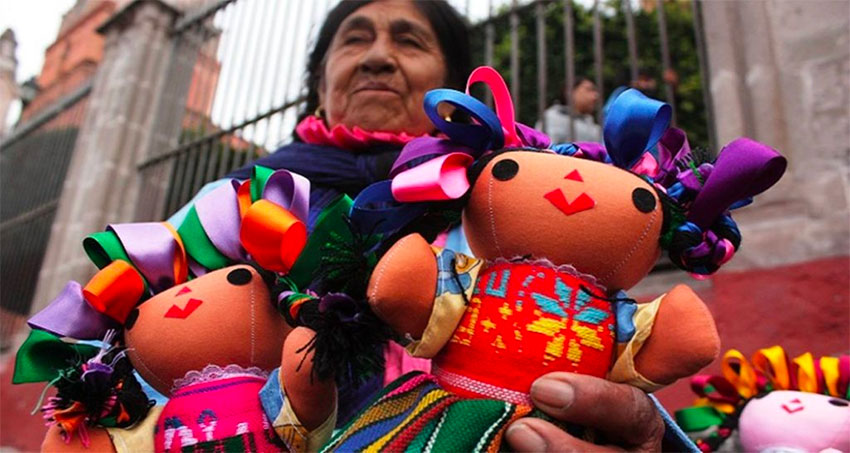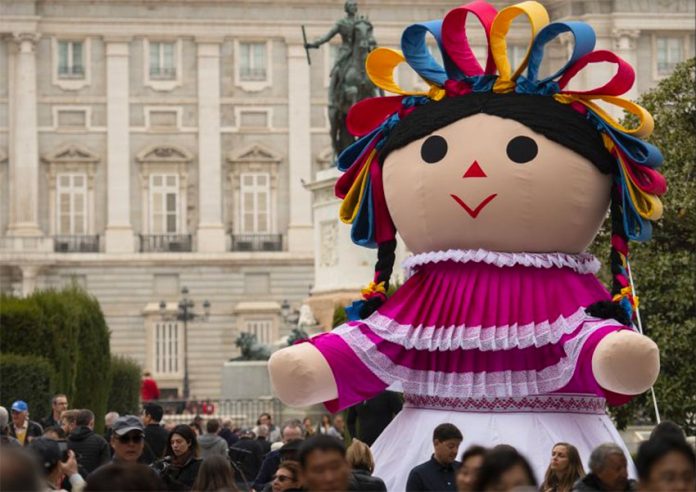Smiling along with her sisters in markets and on street vendors’ stands is the “María” doll. She is readily identified by her wide face, hair braided with multicolored ribbons, and a vaguely indigenous dress.
Now a symbol of Mexico found in tourist promotions all over the world, she has a surprising but unknown backstory.
The doll is strongly tied to the Otomí people of Amealco municipality in southern Querétaro, a few hours northwest of Mexico City. She is big business, with over 500 workshops employing about 70% of the people here. The Otomí, the municipality and the state have promoted the dolls, leading most to believe that she originated here.
But that is not the case.
Her origins, believe it or not, are in Mexico City in the 1970s.

In the mid-20th century, there was a wave of Otomí and Mazahua migration into the capital. These migrants eked out a living working on the streets of Mexico City.
Their presence was not exactly welcomed by established businesses, and the indigenous women were readily identified by their use of traditional clothing. They became stereotyped with the name “María,” the basis of the famous comic figure La India María from Mexican movies and television at that time.
Even more problematic was that these women were subject to harassment from both merchants and local authorities. The city decided to intervene by establishing the Programación y Estudios Económicos (PYEE, Programming and Economic Studies) to provide these women with an alternative.
The program had these women make their traditional handcrafts, mostly embroidery, in two centers based in La Merced and Coyoacán. The city would buy their handcrafts to resell, and provide the women with childcare, nutrition and basic education.
The program was initially successful, attracting over 800 women within a short time.
The María doll, made to represent the Marías who worked on the street, was the idea of the PYEE’s manager, Guadalupe Rivera Marín, daughter of the famous Mexican painter Diego Rivera.

Experts were hired to design the doll and the production method and to train the women how to use industrial sewing machines. The doll’s dress is roughly based on that of the more colorful Mazahua dress but simplified to make it easier and quicker to sew.
By far, the dolls are the most successful thing to come out of the program, but not in the way that was intended.
Over time, the PYEE waned due to continued opposition to the indigenous by merchants, fallout from the 1985 earthquake and administrative/financial problems that were never resolved. Today, all that is left of the original program is a small non-profit called the Sociedad Cooperativa Flor de Mazahua, which is basically one family headed by Antonia Mondragon working out of a home next to the Mexico City airport.
The women who learned how to make these dolls did not keep this knowledge to themselves. The doll and its production “went home” to the Mazahua/Otomí areas in México state, Michoacán, Querétaro and Guanajuato.
The success of the dolls here is likely because of economics. Making a living with handcrafts is not easy anywhere, but far more possible in areas with lower costs of living and fewer alternatives for work.
The dolls are made in all four states but it is the Otomí of Amealco who have capitalized on them the most. Artisans here often tell stories about someone in dire economic straits who used the dolls to overcome the difficulty, and mostly likely believe the tales.
The truth is that Amealco’s legitimate claim to the doll comes from its impressive efforts in both the production and promotion of the Marías, allowing them to have national, and now international recognition.
The artisans here have also taken the next steps in creating newer versions, such as those representing La Catrina, brides, other indigenous groups and even characters from Disney movies. This means that the doll’s identifying characteristic is shifting from the ribbons and dress to the wide, multipaneled head, found on no other doll handcrafted in Mexico.
This lack of awareness about Marias’ origin does have one problem. There has been a campaign in the Amealco area recently claiming that the “María” name is racist. The alternative suggested for the doll is Lele (“baby” in Otomí). The claim is accurate in associating “María” with the negative stereotype, but it forgets that the doll was originally created to represent the street vendors.
The story of the Marías is important in another sense. They are the spark behind a growing trend to make cloth dolls that represent Mexico’s various indigenous groups. Although cloth dolls were made before the Marías, the dolls developed since then have all been for commercial purposes.
They have become an important item for textile artisans, in particular because they are relatively easy to sell.
Mexico News Daily
